Today we’re talking about Auschwitz, and I’m not going to lie…it’s going to be a tough one. No jokes here, kids. Just piles and piles of shit. I know, I know: I’m sorry about the foul language. I realize it’s crass, and unbecoming, and gosh darn unladylike. My grandmother would almost certainly be disappointed with me, and since I sometimes wonder if my cat is actually a reincarnation of my grandma (I’m not even joking here…I really do wonder that), I’m pretty happy he can’t read, because there’s no doubt feline grandma would be disappointed too.
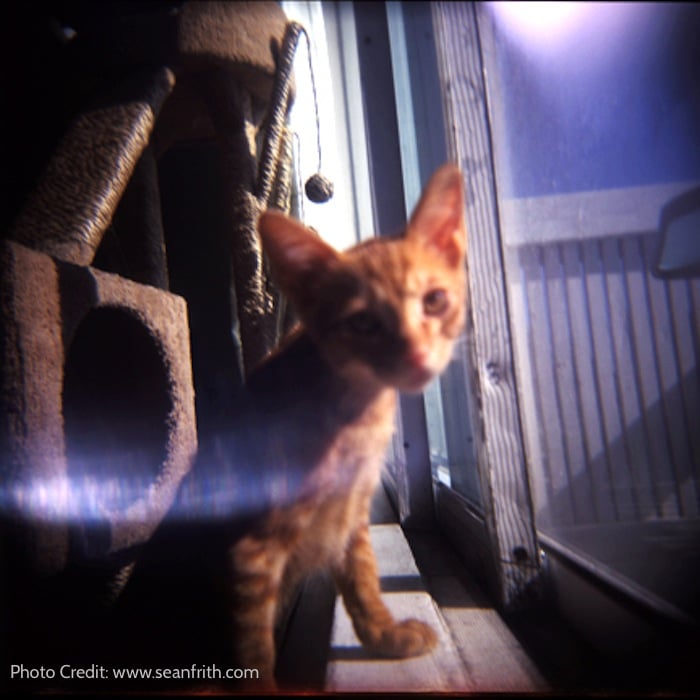
I’ve written before about how a visit to Eastern Europe will pretty much shove your faces in the failings of humanity, and we of course just talked about the Schindler museum in Krakow. But a trip to Auschwitz has to be the most gruesome and grim of Eastern European destinations (except, maybe, Chernobyl?). The place pretty much sucks. And yet, we had to go.
Auschwitz is about 50 km west of Krakow, in the outskirts of the town of Oświęcim, a smallish place that is no stranger to historical action: it has at various times been part of different duchies (including a sweet, sweet stint as an independent duchy – I swear that will be my last light hearted statement in this post), the Kingdom of Bohemia, the Habsburg Empire, Poland, and – rather infamously — Germany.
Since we’re already rolling with the contextual educational stuff, I should probably make a note about the name of the town itself. Oświęcim IS Auschwitz, except the first word is Polish and the second is German. So Auschwitz is really just the German name for the town in which the concentration camp was located. And since we’re now really on a role with the contextual educational stuff, I should probably tell you there are actually two Auschwitz-es (the camps, not the towns) that make up what you probably think of as “Auschwitz:” Auschwitz I, which used to be an army barracks for the Polish Army before the Germans took over, and has been preserved and adapted into a museum, and the Auschwitz II-Birkenau extermination camp, which hasn’t been modified and remains pretty much identical to how it was found by the Red Army. We, like most people, started our journey into darkness at Auschwitz I.
We arrived by minibus from Krakow, and as we drove into the town, all I could think about was what it would be like to be from that town, to grow up seeing a constant parade of visitors coming to your town to gape at what can only be described as an utter failure of the human species. I remember thinking something similar about all the country homes surrounding the Killing Fields in Cambodia, and wonder how residents of these places come to terms with the dense darkness that hovers over the place they call home.
Entering the grounds of Auschwitz I, you will almost immediately come upon this, a visual reminder of the A-holery that went down in Auschwitz:
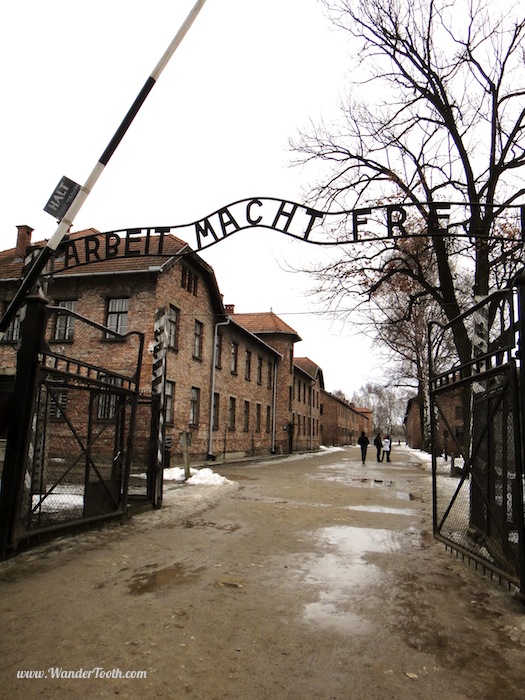
It’s a strange experience walking onto the grounds, because all of the buildings are familiar from my grade 12 history books. I loathed my grade 12 history teacher – his passion for history was palpable, but he was a pedant through and through, and I couldn’t forgive his delivery. Despite this, the facts, figures, stories, and photographs — especially the stories and photographs — from that wasted year have somehow remained in my brain. It’s not until you actually stand on ground drenched in the blood of those statistics that it really begins to take on meaning beyond some long-ago historical awfulness. It’s not until you stand in front of signs like this that the cloud of awfulness that hangs over the place really sinks in…
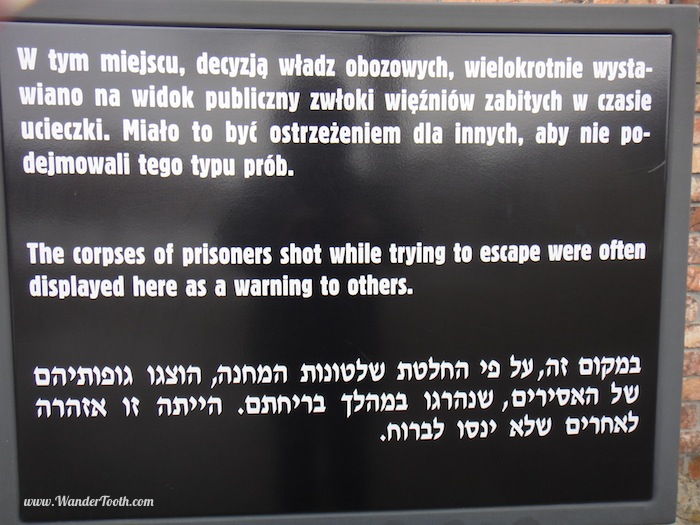
Or stand by the railway on which trainloads of prisoners were brought to their almost certain death at Auschwitz and Birkenau…
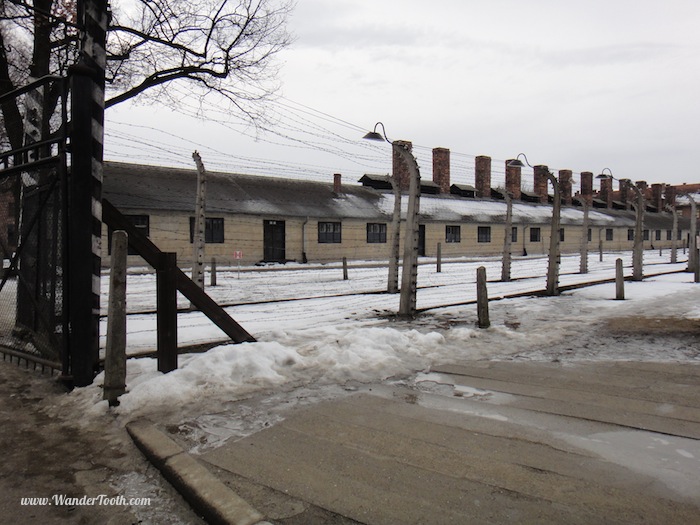
The sheer size of both Auschwitz and Auschwitz II-Birkenau, but especially Birkenau, and the exhibits in the Auschwitz I museum really do put it in perspective, but I’m getting ahead of myself…
At Auschwitz I, each building has a unique exhibit. Some are country specific, with information about how WWII and the Nazi quest for lebensraum affected their country: Hungary, France, the Netherlands, the Czech Republic, and of course Poland each have a dedicated building or area.
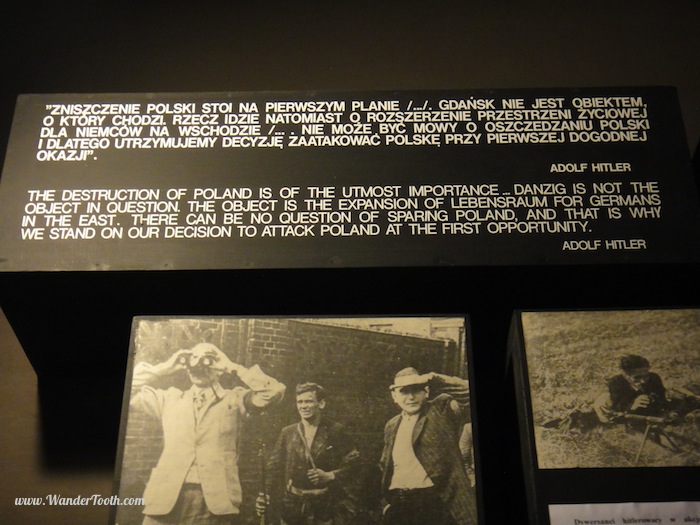
And then, of course, there is a building housing artifacts belonging to victims: suitcases, eyeglasses, clothing, hairbrushes and personal items, prosthetics, and hundreds of kilograms of victims’ hair.
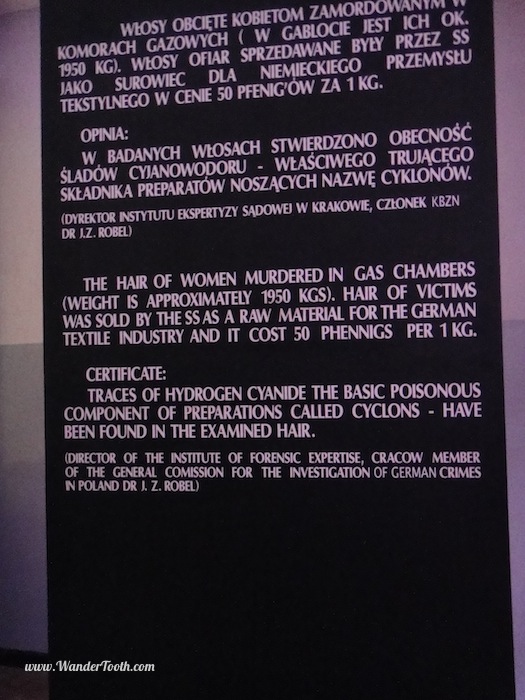
Geoff spent the most time starting at the suitcases, and I can understand why: every suitcase on display belonged to a person, and each represented a life and family ripped apart. It’s hard to look at them without wondering what they thought about as they were packing their suitcase, and whether they knew they were packing for their own death. Along with the suitcases, there are photographs of guards ordering prisoners to dump and separate the contents of the suitcases WHILE the owners were taken directly from the arrival platform to a gas chamber. It’s hard to describe the feeling of looking at those very suitcases decades later, knowing the contents were probably separated and being carted off before the victims had taken their last breath.
From Auschwitz I, we took a free shuttle bus the 3 km to Auschwitz II-Birkenau. Whereas Auschwitz I is moving for the content that’s been developed to tell the stories of the camp, Birkenau is horrible and moving because of its sheer size and purpose. The darkness of the place was enhanced by the fact that it was the middle of the bleak Polish winter: it was cold to start with, but there was also an angry, bitterly cold wind that chilled us to the bone. Plus, it was late afternoon, and the light was actually fading quickly from the overcast sky.
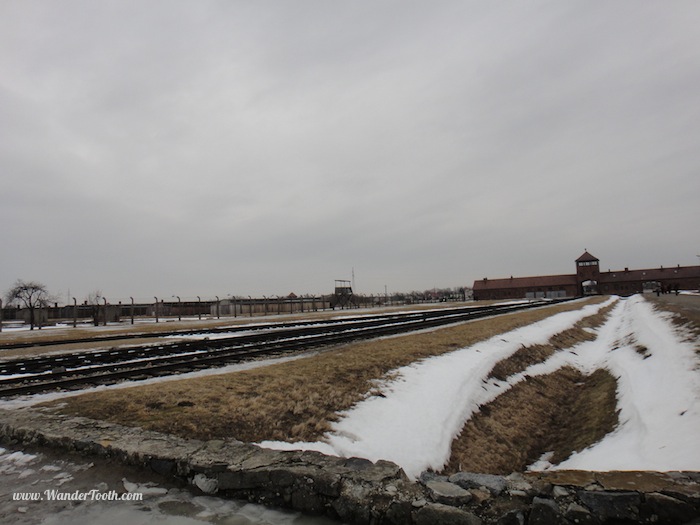
After having visited in the winter, I wouldn’t have wanted to go in the summer. Summer is all cheery and shiny and happy. Winter is the perfect time to appreciate the devastation wreaked at these sites.
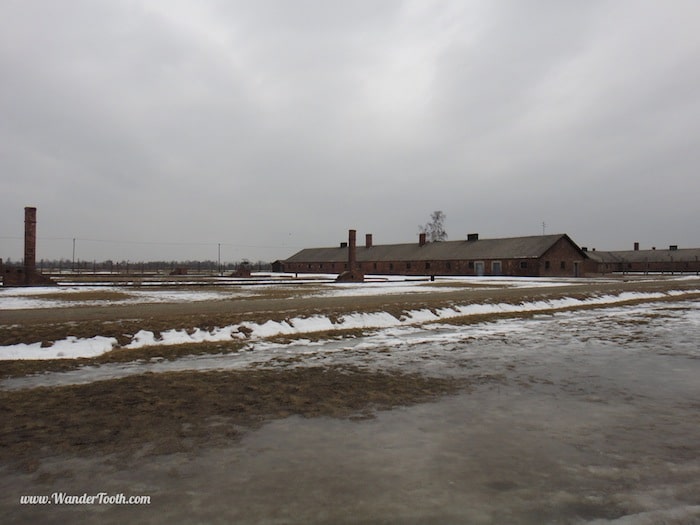
At Auschwitz II-Birkenau, there are rows upon rows of brick buildings where prisoners were housed — 5 of them often sleeping in the same bed — when they weren’t labouring. As we wandered around the grounds, we wondered what the places in which we were standing would have looked like during WWII. What would we have seen and heard and smelled? Trying to imagine what millions of people experienced or felt over the final days of their lives is like being punched in the face over and over again and, to be honest, it was easier to focus on the individual artifacts and photographs at Auschwitz I than the entire picture, laid out for us in rows and rows of brick prisons, at Auschwitz II-Birkenau. Maybe that quote at the Schindler museum — whoever saves one life, saves the entire world — has some relevance here as well: whoever sees the individual stories, sees the entire history. Or maybe I’m full of shit, which is probably true regardless.
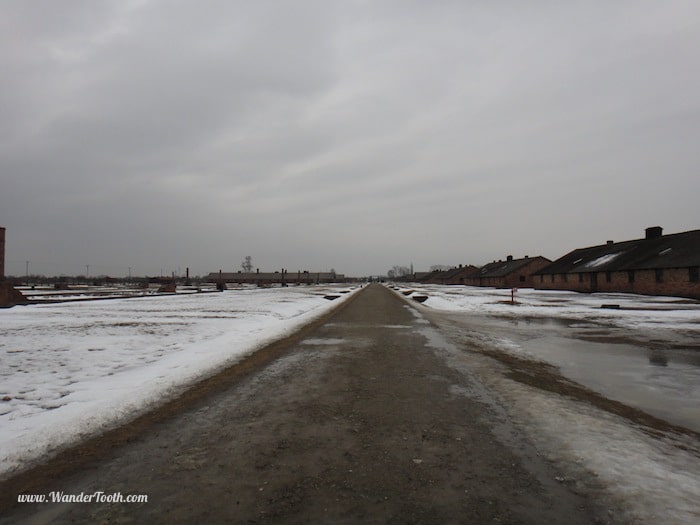
As we left Auschwitz II-Birekenau, a tour group was arriving, and a man who looked to be in his twenties stepped off the bus waving a large Israeli flag, smiling and laughing with his friends. I felt conflicted: on the one hand, I understood this guy’s need for an act of defiance — a good old-fashioned fuck you to those who destroyed so much at these sites and others — but on the other hand, isn’t this site, in part, a cautionary tale about the dangers of nationalism? It seemed callous; I wondered about it well into that evening on our Polish vodka quest and beyond, and I’m still conflicted. As it turns out, it seems the museum seems to be equally conflicted: one of the rules for visiting the Auschwitz museum states “Flying or waving flags on poles is not permitted on the grounds of the former Auschwitz I camp,” but it makes no mention of Auschwitz II-Birekenau.
If you Go:
Take the bus, not the train. If you take the train, you’ll end up about 2km from the museum, and will still have to jump on a bus. If you take the bus, you’ll get almost right to the door. Minibuses leave every hour or so from near Krakow’s train station and will take you right to the front door. It takes just over an hour. There were no savings for buying a return ticket, so just buy a one-way ticket, and then jump on any bus for the return journey. Pay the driver as you get on.
The minibuses from Krakow will drop you off at Auschwitz I, and you can later take a free return shuttle to and from Birkenau. When you enter the museum building, there is a cafe (load up on water; Twix), a place to purchase audio guides, and a theatre where they screen disturbing footage of the first few hours in the camps after being liberated by the Red Army.
As we visited in winter, the museum was only open from 8-3, and we used almost all of that time. While the museum website recommends spending at least 90 minutes at each Auschwitz and Birkenau, we needed more time at Auschwitz, and about 90 minutes at Birkenau. Combined with the bus trip, it ended up being pretty much a full day trip for us.
Entry is free, which is really rather remarkable, but the add-ons cost money: audio guides, tours, the film, etc. You may also may want to make a donation.
If you’re a lover of facts, you may want to do some reading before you go. There is just SO MUCH content, and it’s hard to read everything because there are waves of visitors pretty much forcing you to move along at a certain pace.

We went to Auschwitz a few years ago also as a day trip from Krakow. We booked a bus tour and a guide, so we didn’t need to worry about transport and the tour. I guess it was THE trip that helped me make up my mind and buy a camera (yes, there was a life without one then). We saw a group of Jewish students singing and dancing. I observed the same practice at Jewish cemeteries, obviously they must sing and dance at grave-sites. But they also were very rude and pushed through, as if the whole place belonged to them. I mean yeah they killed Jews here (along with many other nationalities) but there’s no reason to be rude. Ah, sounding so anti-Jew now :-)
Pingback: Wandertooth and the Liebster Award
We haven’t been to Auschwitz but visit Dachau when we were in Munich. It’s a strange overwhelming feeling of negativity that washes over you when you’re in a place with such a horrid past. Hard to describe in words.
I agree Nat. I’ve heard Dachau is an equally horrible place to visit, and yet I think it’s important to preserve these places for history. Thanks for the comment!
We visited on the most gorgeous summer day and you are right – it made for such a confusing experience. You are emotionally wrecked at the same time as thinking how much nicer it is there in summer than in winter. I will admit I was hesitant about visiting at first – thinking I might stay in Krakow for the day instead. But I will never forgot the trip and would encourage everyone to go. We owe it to those who died there.
Hey Jess, thanks for adding your thoughts. I also felt hesitant about going to visit, but am glad I did.
I visited Auschwitz-Birkenau a few days ago and I cannot in words describe what I felt, it was a beautiful sunny day, and death was the last thing on your mind, and then you find yourself standing there, staring in disbelief, at the place where so many people died, and you can almost hear the screams, imagine the terror.
It was the suitcases that really got to me. The suitcases, and the shoes that never again would be filled. The bone fragment still visible by the ash pits in Birkenau made me cry. Its gruesome, and something everybody still should see.
Pingback: Cambodia's Killing Fields - Wandertooth Travel Blog
Indeed one of the most depressing places in Europe but anyway so worth to be visited for the memory of those who died there.
We also felt conflicted by a minority of people there seeming to not show respect for the place, it also took weeks to process the feelings and sights seen there. please take a look at our thoughts from our recent visit at: http://www.followthehound.com/auschwitz/
I am planning a trip for the month to Polish (including visit Auschwitz) with my wife. Very often complains about how bad we have in Russia. Can understand that the world is happening far greater tragedy than the stupid leader (like in Russie).
We found a company that organizes such trips from Krakow. Paste link in the “Website” – can someone with Them worked and can comment?
Sorry for my English, but I’m learning myself and am 64 years old.
До́брый ве́чер Felix!
Thank you for your comment. I am so inspired that you are learning English at 64 years old. I am trying to learn a little Czech right now…and I know До́брый ве́чер is similar to the Czech phrase for good evening :)
I am sorry, but I can’t give you advice about a tour company to help you go to Auschwitz…we took the public bus from Kraków, and did not use a tour company. I think you will have a important experience at Auschwitz and wish you good luck with your holiday and English learning :)
# Summer is all cheery and shiny and happy.
I was there last summer and it was brutally hot. That place is one of extremes in many ways.
Pingback: The 6 Best Day Trips from Prague: Prague Travel Recommendations
Pingback: Sunset March in Nijmegen Netherlands: Why & How to Participate
Informative but the author, Katie Matthews, reveals her lower education level by the profanity she uses, totally unneeded to get the message across. I’ve heard and seen all the words and used them all, but not in public and not in print.
http://www.huffingtonpost.ca/2016/09/27/swear-words-intelligence_n_12213206.html